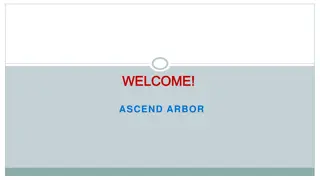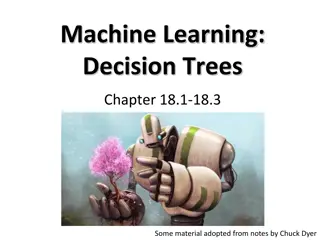Understanding Phylogenetic Trees: An Introduction to Tree Thinking
Explore the fundamentals of constructing and interpreting phylogenetic trees, identifying common ancestors, and understanding evolutionary relationships among species. Learn how to draw trees that represent genealogical connections accurately, and discover the significance of shared, derived characters in depicting relatedness between organisms.
Download Presentation

Please find below an Image/Link to download the presentation.
The content on the website is provided AS IS for your information and personal use only. It may not be sold, licensed, or shared on other websites without obtaining consent from the author. Download presentation by click this link. If you encounter any issues during the download, it is possible that the publisher has removed the file from their server.
E N D
Presentation Transcript
Tree Thinking: Reading and Interpreting Phylogenies
Review: Constructing Phylogenetic Trees You are now able to construct a phylogenetic tree using character data a. Trees are built with shared, derived characters that indicate relatedness b. Trees illustrate degrees of relatedness c. Nodes represent past divergent events
Learning Objectives You should be able to: Correctly interpret phylogenetic trees Identify the most recent common ancestor of a given group Draw trees that show equivalent genealogies
Is the frog more closely related to the fish or the human? a. Fish b. Human c. Equally related to both d. There is not enough information to decide
Is the frog more closely related to the fish or the human? a. Fish b. Human c. Equally related to both d. There is not enough information to decide
Is the frog more closely related to the fish or the human? Time
The frog is more closely related to the human than the fish Time These two trees show the same evolutionary history!
Remember Trees can be drawn in different ways = What really matters? More recent common ancestor
Based on this tree, who is the horses closest relative? 4 3 2 a. Lizard b. Seal c. Tie between the lion and cat d. Tie between the seal, cat, and lion e. Tie between the seal and the lizard 1
Known relationships among the Hominoids (apes): 1. Humans and chimps are each other s closest relatives 2. The closest relative of the gorilla is a tie between humans and chimps 3. The closest relative of the orang is a tie between humans chimps and gorillas In Groups: Draw as many trees as you can that all illustrate the SAME correct genealogical relationship
Which tree is a different genealogy from the other three? A B C D
Learning Objectives You should now be able to: Correctly interpret phylogenetic trees Identify the most recent common ancestor of a given group Draw trees that show equivalent genealogies
Questions? Kris Karsten karsten@callutheran.edu Cath Kleier ckleier@regis.edu Frank Messina frank.messina@usu.edu Theresa Rogers terogers@callutheran.edu Kristin Swihart swihart@colorado.edu Becky Williams toxwilliams@gmail.com Facilitated by: Stanley Lo stanley- lo@northwestern.edu
Upcoming Topics Accurately determine relative timing of the evolution of characters of interest by mapping traits onto a tree Recognize that scientific names (taxonomy) do not always match up with evolutionary relationships (systematics) Applications of phylogenetics
Alignment Learning Objective Learning Goal Assessment Learning Activity What will students do to learn it? What will students learn? If they have learned it, what will students know and be able to do? Students will: How will students demonstrate they know it or are able to do it? Students will understand phylogenetic trees as representations of evolutionary history Formative: Students will: Correctly interpret phylogenetic trees Will take place within each of the learning activities with feedback. Answer clicker questions on tree interpretation Identify the most recent common ancestor of a given group Justify answers to a partner Summative: All of the learning objectives are addressed by distinguishing between different genealogies Groups translate written summary of relationships into alternative trees Draw trees that show equivalent genealogies























